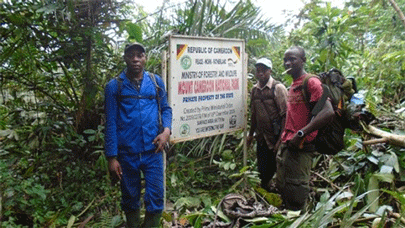Conservation of the Mount Cameroon Francolin
By Francis Guetse, Taku Awa II, David Hořák and Richard Tamungang
 |
|
Team francolin. Photo credit: Francis Guetse. |
Mount Cameroon francolin (Pternistis camerunensis) is one of the most endangered and least understood birds in the world. This gamebird is endemic to Mount Cameroon which is facing various threats such as volcanic eruptions, encroachment by Prunus africana and unchecked hunting.
Mount Cameroon is situated on the coast of south–west Cameroon, between 3°57'- 4°27' N and 8°58'-9°24'E, where its slopes rise from the Gulf of Guinea, and includes two major biomes (Guineo-Congolian forest and afro-montane forest). The montane forest that is recognized as home for endemic and threatened species has higher death of trees than other vegetation types (Forboseh et al., 2011). The regular burning of the grassland around the montane forest further exacerbates the problem because it leads to the destruction of the habitat, nests, eggs and juveniles of ground nesting birds such as the Grey-necked Picathartes and the Mount Cameroon francolin (Horak, 2014).
The ecology of this francolin is still not understood and its population was estimated to be 600-1,700 mature individuals in 1984. However, a survey in 2014, with methods such as point count, random walking and mist net, did not yield any sighting of the bird (Bayly and Motombe, 2004, and Djomo et al., 2014). Given the critical situation, we used audio playback technique (playing a recording of the francolin’s song) combined with point transects to maximize the chance of detection (Sutherland et al., 2004) of the cryptic and shy Mount Cameroon francolin. To reduce bias, a pilot survey was undertaken at the beginning of the study.
All of our transects (17 in total) cut across the altitudinal gradient of Mount Cameroon National Park (MCNP) every 500m. The playback was employed every 300 m along each transect of 1.5 km of length and responses noted and the GPS location recorded. The process was conducted in the morning (7.00-11.30 am) and in the evening (3.30-5.00 pm). Habitat surveys were conducted after playback sampling was completed each day and data collected for 50m radius in each station and it included canopy cover, dominant vegetation, presence or absence of bare soil, ground vegetation height, grass cover, big and small trees, scrub, tree height and threats indices. We determined land cover and land use to quantify loss of francolin habitats from satellite images (2008 and 2015).
Between mid-July and mid-August 2016, playbacks were conducted at 85 points. Responses from 11 individuals and 15 groups at 26 points were obtained. Thus, Mount Cameroon Francolin does exist and playback method can be used to detect its presence.
Though our data did not yield an estimate of the population size of the francolin, we inferred that the species occurs at relatively low densities, and an assessment of the conservation status of this species is urgently required as per IUCN criteria.
We found the bird was dispersed in primary and secondary montane forest, elephant bush and shrubland at an altitudinal range of 1023-2186 meters as compared to an earlier report of 850-2100 meters. The open forest, elephant bush and shrubland decreased predominantly due to bushfire. Apart from habitat degradation, hunting pressure with indiscriminate hunting/trapping such as snares, cables and shotgun use are still prevalent in Mount Cameroon.
References
Bayly, N., And Motombe, F. N. (2004). Final Report of An Ornithological Survey of Mount. Wildlife Conservation Society. 47p
Djomo, N. E., Sedláček, O., Bayly, N., Albrecht, T., Ferenc, M., Reif, J., Motombi, F. N. & Hořák, D. (2014). Comparison of avian assemblage structures in two upper montane forests of the Cameroon volcanic line: lessons for bird conservation. Biodiversity and Conservation 23:1469–1484.
Forboseh, P. F., Sunderland, T.C.H., Comiskey, J.A, and Balling, M. (2011). Tree Population Dynamics of Three Altitudinal Vegetation Communities on Mount Cameroon (1989-2004). J. Mt. Sci. (2011) 8: 495–504 DOI: 10.1007/s11629-011-2031-9
Hořák. (2014). Bird and plant diversity on elevational gradient of Mt. Cameroon. Preliminary project report for Mt. Cameroon NP. Charles University in Prague, Czech Republic.http://allafrica.com/stories/200901200208.html